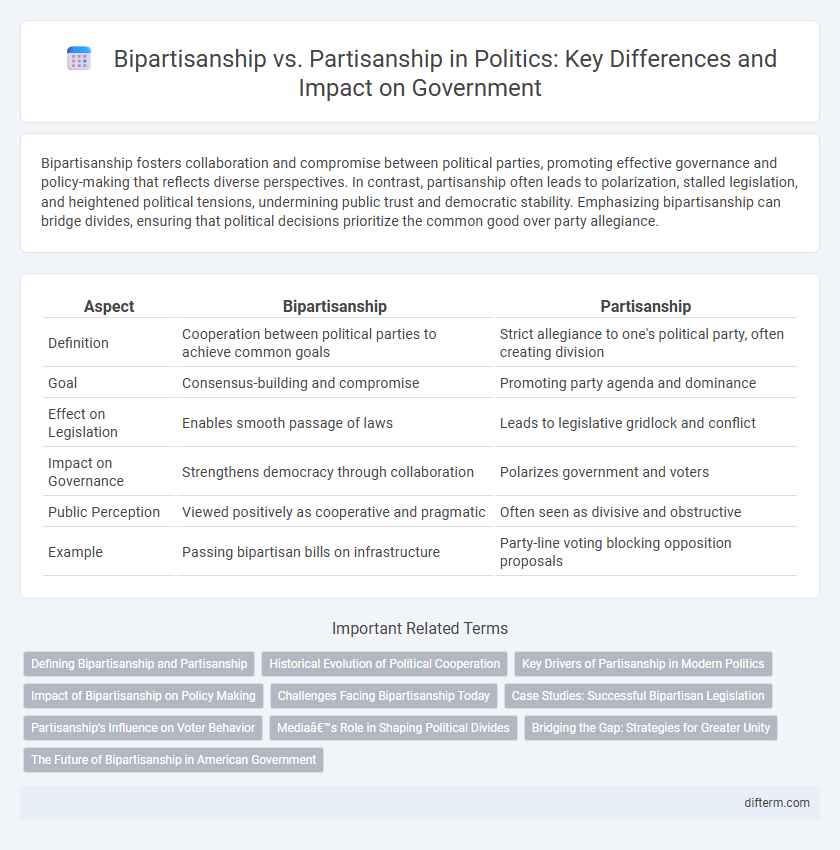Bipartisanship fosters collaboration and compromise between political parties, promoting effective governance and policy-making that reflects diverse perspectives. In contrast, partisanship often leads to polarization, stalled legislation, and heightened political tensions, undermining public trust and democratic stability. Emphasizing bipartisanship can bridge divides, ensuring that political decisions prioritize the common good over party allegiance.
Table of Comparison
| Aspect | Bipartisanship | Partisanship |
|---|---|---|
| Definition | Cooperation between political parties to achieve common goals | Strict allegiance to one's political party, often creating division |
| Goal | Consensus-building and compromise | Promoting party agenda and dominance |
| Effect on Legislation | Enables smooth passage of laws | Leads to legislative gridlock and conflict |
| Impact on Governance | Strengthens democracy through collaboration | Polarizes government and voters |
| Public Perception | Viewed positively as cooperative and pragmatic | Often seen as divisive and obstructive |
| Example | Passing bipartisan bills on infrastructure | Party-line voting blocking opposition proposals |
Defining Bipartisanship and Partisanship
Bipartisanship involves cooperation between two opposing political parties to achieve common legislative goals, promoting compromise and unity in governance. Partisanship denotes strong allegiance to a specific party, often resulting in polarized decision-making and ideological rigidity. Understanding these dynamics is essential for analyzing legislative effectiveness and democratic stability.
Historical Evolution of Political Cooperation
Bipartisanship has historically emerged during critical moments in U.S. history, such as the New Deal era and the Civil Rights Movement, when collaboration across party lines facilitated significant legislative achievements. In contrast, partisanship intensified during the late 20th and early 21st centuries, driven by ideological polarization and primary election dynamics. The historical evolution of political cooperation reflects fluctuating party relationships influenced by social movements, economic crises, and shifting media landscapes.
Key Drivers of Partisanship in Modern Politics
Key drivers of partisanship in modern politics include ideological polarization, media fragmentation, and the strategic use of partisan messaging by political leaders. Social identity theory also plays a significant role, as individuals increasingly align their political beliefs with group identities, intensifying division. The rise of social media platforms amplifies echo chambers, reinforcing partisan viewpoints and reducing exposure to opposing perspectives.
Impact of Bipartisanship on Policy Making
Bipartisanship in policymaking fosters collaboration between political parties, leading to more balanced and sustainable legislation that reflects a wider range of public interests. This cooperative approach often results in increased legislative efficiency, reduced gridlock, and policies with greater legitimacy and public support. In contrast to partisanship, bipartisanship encourages compromise and pragmatic solutions essential for addressing complex national challenges.
Challenges Facing Bipartisanship Today
Bipartisanship faces significant challenges due to increasing ideological polarization and the rise of partisan media amplifying division. The erosion of trust between political parties and heightened political tribalism hinder collaborative policymaking efforts. Structural factors like gerrymandering and primary election pressures further exacerbate the difficulty of achieving bipartisan consensus in today's political landscape.
Case Studies: Successful Bipartisan Legislation
The 1996 Welfare Reform Act and the 2010 Affordable Care Act both exemplify successful bipartisan legislation, demonstrating how cross-party collaboration can produce effective policy outcomes. In these cases, lawmakers from both parties negotiated compromises that balanced diverse interests, resulting in sustainable reforms with broad support. Such case studies highlight the potential for bipartisanship to overcome partisan gridlock and achieve meaningful legislative progress.
Partisanship's Influence on Voter Behavior
Partisanship significantly shapes voter behavior by fostering strong emotional and psychological attachments to political parties, which often lead individuals to prioritize party loyalty over policy evaluation. This loyalty influences voting patterns, resulting in consistent support for party candidates regardless of their specific platforms or performance. Research indicates that heightened partisanship contributes to voter polarization, reducing the likelihood of swing voting and increasing political division within the electorate.
Media’s Role in Shaping Political Divides
Media outlets significantly influence political polarization by framing issues through partisan lenses, often amplifying ideological divides. Selective reporting and echo chambers perpetuate biased narratives, limiting exposure to diverse perspectives and reinforcing partisan identities. Consequently, the media environment hinders bipartisan dialogue and deepens the political chasm between opposing camps.
Bridging the Gap: Strategies for Greater Unity
Bridging the gap between bipartisanship and partisanship requires fostering open dialogue and promoting collaborative policymaking among diverse political parties. Implementing cross-party committees and encouraging compromise on key legislative issues can reduce polarization and build mutual trust. Emphasizing shared goals, such as economic growth and national security, helps unify lawmakers beyond party lines.
The Future of Bipartisanship in American Government
Bipartisanship in American government faces increasing challenges amid polarized political landscapes and ideological divides between major parties. Emerging trends suggest that bridging partisan gaps requires renewed commitment to collaborative policymaking and fostering mutual trust among lawmakers. The future of bipartisanship hinges on structural reforms and grassroots efforts that prioritize common goals over party loyalty.
bipartisanship vs partisanship Infographic

 difterm.com
difterm.com